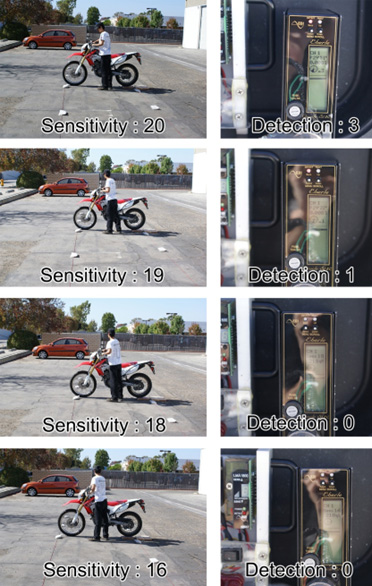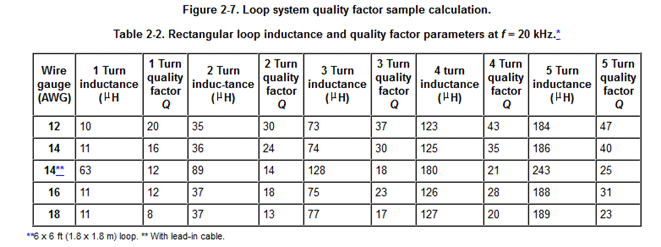Tests & Results
16 AWG vs. 24 AWG Loop Detection Comparison
It is commonly said that wire gauge doesn’t affect loop performance, is this true with large loops or loops with long lead-in lengths?
Purpose:
- Dispel myth that wire gauge size does not affect loop performance.
- Observe and record if there is any difference in detection strength(performance) for a 6’x50’ loop made with 16AWG vs 24AWG.
Hypothesis:
When a loop gets larger the Q Factor (Quality Factor) becomes more important, we expect to see dramatically better detections on the #16 AWG loop vs. #24 AWG loop.
Materials:
- (1) 6’x50’ loop with 20’ of lead-in 24AWG (112’ perimeter loop) 2 turn loop
- Additional 80’ of 24 AWG lead-in
- (1) 6’x50’ loop with 20’ of lead-in 16AWG (112’ perimeter loop) 2 turn loop
- Additional 80’ of 16 AWG lead-in
- EDI LMA 1800 Detector
- EDI Oracle Detector
- Sand bags to hold the loops in place
- Motorcycle – Honda CRF 250L
Procedure and Results:
The 16 AWG was laid out and covered in sandbags to prevent the wire from moving and causing false detections, then it was connected to the detectors and a motorcycle was carefully walked over the center of the loop using wooden planks to prevent the motorcycle from coming in contact with the loop wire. The 24 AWG loop was laid out in the same area and the test was repeated and the results were recorded.
16 AWG Loop Results:
Driving Down Center of the 16 AWG 112′ Loop – EDI LMA 1800
| Vehicle Type | Sensitivity Level | Detection |
| Motorcycle | 9 | 2 |
| Motorcycle | 8 | 1 |
| Motorcycle | 7 | 0 |
the car detection strength at these levels is solid – when the motorcycle sits over the loop the detection is not lost.
24 AWG Loop Results (EDI LMA 1800 Detector):
Driving Down Center of the 16 AWG 112′ Loop – EDI LMA 1800
| Vehicle Type | Sensitivity Level | Detection |
| Motorcycle | 9 | 0/ no detection |
| Motorcycle | 8 | 0/ no detection |
| Motorcycle | 7 | 0/ no detection |
Next we tried the same test with the EDI Oracle Detector Module:
16 AWG Loop Results (EDI Oracle Detector):
Driving Down Center of the #16 AWG 112’ Loop – Oracle
| Vehicle Type | Sensitivity Level | Detection |
| Motorcycle | 20 | 5 |
| Motorcycle | 18 | 3 |
| Motorcycle | 16 | 1 |
24 AWG Loop Results (EDI Oracle Detector):

Driving Down Center of the #24 AWG 112’ Loop – EDI Oracle
| Vehicle Type | Sensitivity Level | Detection |
| Motorcycle | 20 | 3 – Detection is not solid, is lost after a few seconds. |
| Motorcycle | 19 | 1 – Detection is not solid, is lost after a few seconds. |
| Motorcycle | 18 | 0/ no detection |
| Motorcycle | 16 | 0/ no detection |
(approx 15-20 seconds) on both levels, it decreases and then falls to 0 quickly.
#24 AWG loop with 100’ of lead-in
We added the 80’ of 24 AWG lead-in which brought the total lead-in length to 100’ and repeated the test on the loop.
Driving Down Center of the #24 AWG 112’ Loop w/100’ of lead-in – Oracle
| Vehicle Type | Sensitivity Level | Detection |
| Motorcycle | 20 | 0/ no detection |
| Motorcycle | 19 | 0/ no detection |
Adding 80’ of lead-in increased the total feet of wire by 160’. (80’ x2)
The loop originally had 224’ (112’ x2) of wire in the loop section and 40’ (20’ x2) in the lead-in section for a total of 264’ of wire. Adding 80’ of lead-in (160’ of wire) increases the total length of wire by 60.6%.
Conclusion:
Wire gauge affects the performance of inductance loops, this is a fact that has been well documented in the traffic industry. For gates the difference in performance can be easily seen when comparing large loops or loops with long lead-in lengths.
In our test we found that the #24 AWG wire had 66% decrease in detection strength (performance) vs. the #16 AWG loop.
For small loops such as a 6×6’with little or no lead-in the difference in performance might be negligible, but for larger loops or loops with longer lead-in it is significant.
The difference in performance can easily be explained by Q Factor (Quality Factor), thinner (higher gauge) wire such as #24 AWG has more resistance than #16 AWG, because of the resistance (and other factors) thinner (higher gauge) wire has more energy loss than thicker (lower gauge) wire which results in poorer performance as the loop becomes larger or the lead-in length increases.
The chart below is from the U.S. Department of Transportation Federal Highway Administrations Traffic Detector Handbook. It shows how the Q factor increases or decreases based on wire gauge, lead-in length, and number of turns.

As you can see when comparing the 2 turn #14 AWG with and without lead-in the q factor drops over 40% from 24 to 14. Most detectors work best with loops that have a Q Factor greater than 5. The calculations for Q Factor with lead-in are not provided for the other wire gauges in this chart, but we know that the Q factor will decrease as lead-in is added.
Because lead-in is often run for long distances in intersections many DOTs have specified #12-16 AWG as the thinnest gauge that should be used to prevent the Q Factor of loops from falling below the minimum acceptable standard.
What this Means, BD Loops Comments:
There is a pervasive myth in our industry that wire gauge does not affect loop performance (aside from tensile strength). This was a theory that was tested years ago with 6’x6’ loops wrapped with different gauge wires and little to no lead-in (the test does not specify), the results showed that there were slight differences in performance but it was negligible. In our opinion the test had some obvious issues, such as using a small loop size and not including lead-in the test which call the results of the test into question.
The 6’x6’ test did not test loops with longer lengths of lead-in or larger loops, which is where performance differences would become more apparent. For this reason we find the test to be unrealistic as the gate industry deals with loops that have longer lead-in and are of a larger size.
The difference in performance can easily be explained by Q Factor, thinner (higher gauge) wire such as #24 AWG has more resistance than #16 AWG, because of the resistance (and other factors) thinner (higher gauge) wire has more energy loss than thicker (lower gauge) wire which results in poorer performance as the loop becomes larger or the lead-in length increases.
The larger a loop is, the more important wire gauge is to its performance. In our results we had a 66% loss in detection strength when comparing #16 vs. #24AWG. Besides the loss in detection we were no longer able to obtain solid detections on the motorcycle, the loop would pick up the motorcycle and then the detection would slowly drop until it was lost.
On the #16 AWG Loop the detections stayed solid, even when using the LMA 1800 detector with 9 levels of sensitivity.
Wire gauge does affect loop performance, and it is most noticeable on large loops. Large loops, or loops with long lead-in lengths should not be wrapped with wire thinner than #16 AWG.
A major problem we see with the myth that wire gauge doesn’t matter is that installers often buy spools of #18-#20 AWG wire unaware that the wire should not be used for large loops or for loops with long lead-ins. Higher gauge (thinner) wire spools do not come with warnings explaining that they should only be used for small loops with very short lead-in lengths. Installers are often under the false impression that they should not wrap loops larger than a 6×20 because thinner gauge wire is so common in our industry. Nobody ever explains to the installers that they can wrap larger loops, or have longer lead-in if they use lower gauge (thicker) wire.
Installing loops is time consuming, the best advice we can give installers is not to skimp on the loop design with thinner wire (higher gauge).
We suggest a minimum of 16 AWG be used for best performance.
BD Loops
The Loop Experts!
BD Loops was founded in 2001. Their preformed loops and accessories are designed with the installer in mind. BD Loops offers a complete loop system solution including preformed direct burial loops, preformed saw-cut loops, loop sealant, blades, testing devices, and installation tools. BD Loops has a reputation for reliability and ease of installation. They pride themselves on the quality of their products and their commitment to providing excellent customer service and support. BD Loops preformed loops are made in the USA at their facility in Placentia, CA.

